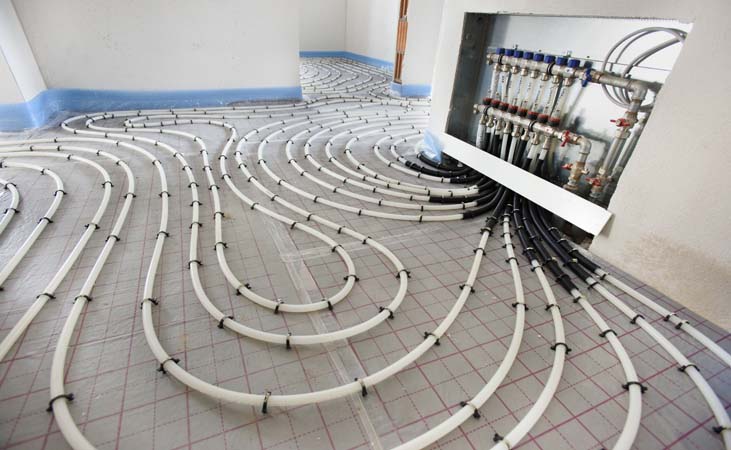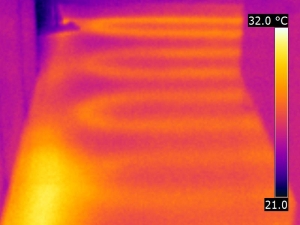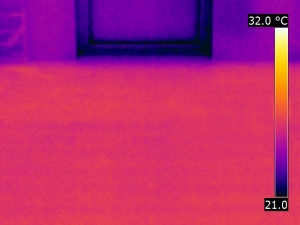Underfloor heating is now installed by every second builder in his own home. However, on closer inspection, the heating variant shows not only advantages, but also has disadvantages! In this article we have summarized for you the three biggest disadvantages of classic underfloor heating:
Disadvantage #1: Inertia of underfloor heating
The most significant disadvantage of classical floor heating is the “sluggish” response time when heating rooms. The pipes of the heating system are located about 5-10 cm below the top layer, so the heat must first pass through the screed, which is several centimeters thick. Only after at least 6-7 hours, the desired temperature is released into the room.
This slow process therefore requires heating even on days when the rooms are not in use. Accordingly, lowering the temperature overnight or switching it off quickly on hot days is only possible to a limited extent.
Because only after several hours of reheating, a comfortable room temperature is reached again. The constant heating up also has a negative impact on your energy costs.
Solution: Plan more heating surface, e.g. wall and ceiling surfaces, thus a lower temperature is required and you reach the comfortable temperature faster.
Our professional tip: Keep the temperature of the underfloor heating constant at 23 °C the temperature of the soles of the feet. You can then adjust the wall heating depending on how you feel. It is particularly responsive because there is less coverage and it operates mainly via radiation.
Disadvantage #2: Costly retrofitting
Installation costs of classic underfloor heating systems in new buildings are now almost identical to those of alternative heating options. The situation is different for retrofitting. Either the floor must be raised by a few centimeters or the necessary channels must be milled into the floor. Depending on the floor construction and the value of the topsoil, this can be expensive.
Alternatives include electric underfloor heating and thin-bed underfloor heating systems, which can be retrofitted with relatively little effort. The main disadvantage is that these variants are mainly single-room solutions and the operating costs are very high .
Solution: Another option in the renovation is the surface heating. This can be installed not only in the floor, but also on the wall and / or ceiling. This allows the costly ground retrofit to be bypassed.
Our professional tip: Keep the temperature of the underfloor heating constant at 23 °C the temperature of the soles of the feet. You can then adjust the wall heating depending on how you feel. It is particularly responsive because there is less coverage and it operates mainly via radiation.
Disadvantage #3: Circulation and vein problems
As long as the right temperature is set, underfloor heating basically poses no danger to your circulation and veins. However, the slow response time of classic underfloor heating systems, often tempts people to turn up the temperature too high.
Furthermore, with some classic floor heating systems, there is the challenge of the “warm-cold-cold” effect. This occurs when the heated hose is laid with too great a distance between them or when the heated hose cools down too much along its length. This makes some areas feel too warm, and others too cold. To compensate for the temperature differences, even more heating is required.
At this point, it becomes harmful to your circulation and veins. Although the heat does not cause varicose veins. However, existing ones are more stressed as vessels dilate and congestion effects increase.
According to the DIN EN 1264 standard, only temperatures up to 29 °C are permitted for underfloor heating systems in occupied areas. Nevertheless, permanent 29 °C is not conducive to health for people who already have circulatory and venous problems. That’s why it’s important that you don’t set the temperature of your underfloor heating higher than the temperature of the soles of your feet.
Solution: Choose a floor heating system that has the most uniform surface temperature possible. A small pipe spacing prevents large fluctuations.
Our professional tip: Underfloor heating with parallel flow reduces, through the Tichelmann system, the cooling in the length of the pipe. This way your underfloor heating loses less temperature and the surface has an even more even temperature!
Conclusion
Whether you install radiant floor heating in your new construction or retrofit it in an old building, it will enhance your home comfort. With many classic underfloor heating systems, however, you have to make sacrifices and accept disadvantages. Egger Wohlfühlklima specializes in eliminating these disadvantages.
The egger system, produced especially by us, has the claim to optimize living comfort. You want to know more about the egger system and if it can be integrated into your project? Then inform yourself further and click here.





